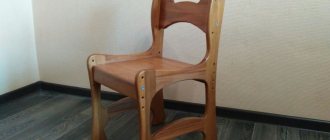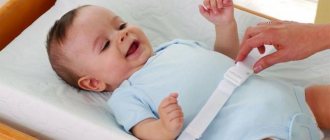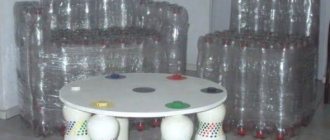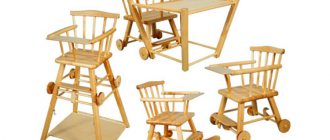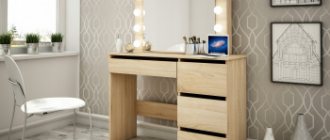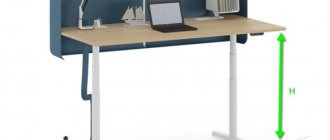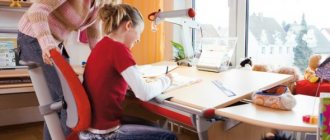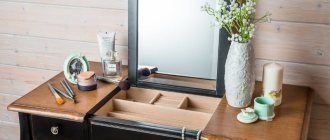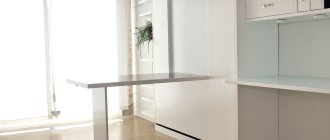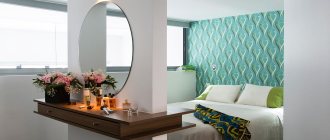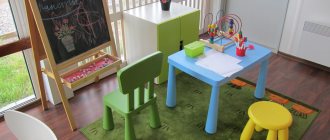From the moment children begin to sit and walk, games and creative activities at the table become important for them. Up until the start of school and throughout the school years, every child spends a lot of time each day sitting in a chair at his or her table. This furniture is simply necessary for games, creative activities and study, so all parents are required to purchase it. The main thing that they must take into account is that the choice of tables and chairs for children should be made responsibly based on many factors, which will be discussed in this article.
What requirements must a children's table with a chair meet?
When choosing a set of children's tables and chairs for a child's activities in the store, parents should be vigilant. Not all furniture models offered by sellers can really benefit children. The requirements for tables and chairs for children are strict:
- All materials and components that make up the items must be of excellent quality, completely safe for the delicate health of the baby, non-toxic, and hypoallergenic. It is especially important to pay attention to the external covering of the furniture, as well as to the fittings;
- structures must be especially strong, high-quality, durable and stable. This will allow them to be used safely for quite a long time. It is important that all bolts are fully tightened, the legs do not wobble, and the folding mechanisms (if any) operate smoothly;
- the contours of the products should be smooth, without sharp corners, and the total weight of the items should be small. This will minimize trauma to children during classes.
Rules for placing a table in a room
Incorrect positioning of the table can negatively affect the child's health. To avoid installation errors, you should pay attention to several factors :
- Lighting . The light should fall from the side without creating a shadow. The ideal option is to place the table directly in front of the window.
- By placing the table near the window, make sure that the window frame is of good quality and that there are no drafts .
- It is not advisable to install furniture at a distance closer than 15-20 cm from heating radiators . Constant exposure to high temperatures will damage the furniture and reduce its service life.
- Make sure there is an outlet . It is best to avoid using baby carriers in the baby's room.
It is important to note that:
- if the child is left-handed , the lighting should come from the right,
- if right-handed - on the left.
Take into account all the location rules so that the table complements the interior favorably and does not harm the child.
Options for installing a table near a window
Installing a tabletop near a window is an excellent solution for saving space and improving illumination in the work area. Sunlight promotes the production of vitamin D, and lighting plays an important role in shaping a child’s visual perception of the world. But when locating the work area near a window, you need to pay attention to the intensity of the lighting. If the window faces the sunny side , buy blinds to regulate the intensity of sunlight. Keep in mind that the table cannot be placed near radiators, which are often installed under the windowsill. Do not choose a tabletop that is too wide - it will block access to window fittings. It is important to think through all the details before installation; if necessary, it is better to contact a specialist. Remember that the table is the main element of the children's room, on which the comfort and health of your child depends. Approach the choice of this furniture with special care.
The article was written for the site.
Tags:Children's room, Table
Kinds
Now on the market you can find a lot of models of children's tables and chairs for children 2-3 years old and primary schoolchildren, each of which belongs to a specific group. Belonging to them implies the presence of typical advantages and disadvantages that should be taken into account when selecting furniture:
- transformers. Such items are multifunctional. By laying out and folding some parts in the right way, you can use them not only for learning, but also for, for example, feeding or games, creativity. Transforming tables are the most convenient and last a long time, but are expensive;
- with adjustable height. This is furniture of standard designs with the ability to adjust the height of the highchair and table to suit the child’s changing parameters. It is also not cheap, but it fully pays for itself over many years of service. And, most importantly, it protects the health and well-being of children due to the changeability of the sizes of children's tables and chairs;
- folding. Very compact and convenient, easy to transport, store and maintain, and often inexpensive. Disadvantages: usually last less than others, not as stable as stationary ones;
- educational chairs and children's tables with additional devices for study and creativity. Magnetic and slate table tops, built-in holders for books, cups, accessories, toys, figurines and games included - this and much more will entertain the baby while parents are busy, and will also allow him to learn new things while playing.
GOST standards for furniture for kindergartens
Children's furniture differs from adult furniture primarily in size. In our legislation, such sizes are called “height groups” (they are also children’s furniture groups). There are 4 special GOSTs that establish such height groups for preschoolers. Useful links to full versions of these documents will be below.
- GOST for children's tables
Until October 1, 2021, GOST 19301.1-94 was in force. Today GOST 19301.1-2016 is in force. Children's preschool furniture. Functional dimensions of tables
This standard applies to children's tables that are used in preschool institutions and at home, except for play and transformable tables. The document divides children's tables into 5 types: four-seater, two-seater with and without drawers, two-seater trapezoidal (optional), as well as single-seater and with adjustable parameters. Here is a table of height correspondences in millimeters:
| Table number | Average height of children (mm) | Height group (mm) |
| 00 | 750 | Up to 850 inclusive |
| 0 | 900 | From 850 to 1000 inclusive |
| 1 | 1050 | From 1000 to 1150 inclusive |
| 2 | 1200 | From 1150 to 1300 inclusive |
| 3 | 1350 | From 1300 |
A separate section of GOST is devoted to the functional dimensions of children's tables (length of the lid, height of the working plane from the floor, etc.) depending on the height group. In paragraph 3.6. GOST states that the corners of table tops should be blunted (rounding radius 10-50 mm). This is the basis for Internet advice that children's center furniture should not have sharp corners.
View the full text of GOST 19301.1-94. you can here.
- GOST for children's chairs
Until October 1, GOST 19301.2-94 was in force. Today GOST 19301.2-2016 is in force. Children's preschool furniture. Functional dimensions of chairs The standard applies to children's chairs that are used in preschool institutions and at home, except for play and transformable ones. The document divides children's chairs into two types: chairs with constant parameters and chairs with adjustable parameters (transformable chairs).
The markings for the height groups of the chairs correspond to the same markings for the tables.
| Chair number | Average height of children (mm) | Height group (mm) |
| 00 | 750 | Up to 850 inclusive |
| 0 | 900 | From 850 to 1000 inclusive |
| 1 | 1050 | From 1000 to 1150 inclusive |
| 2 | 1200 | From 1150 to 1300 inclusive |
| 3 | 1350 | From 1300 |
Height, seat depth and other parameters are indicated in the “Dimensions” section. View the full text of GOST 19301.2-2016. you can here.
- GOST for children's beds
The situation here is similar: until October 1, 2021, GOST 19301.3-94 was in force. Today the new GOST 19301.3-2016 is in force. This standard is intended for children's beds that are used in the bedrooms of preschool institutions and at home. In accordance with the document, children's beds are manufactured in two types: beds with a fence and a bed of variable height for children under 3 years old, as well as beds for children aged 3 to 7 years. There are no height groups here. But there are functional sizes of beds for the safety of children, including possible side rails. View the full text of GOST 19301.3-2016. you can here.
- GOST for other children's furniture
This is GOST 26682-2016. Furniture for preschool institutions. Functional dimensions. The document also came into force on October 1, 2017, replacing GOST 26682-85. The standard applies to other furniture for kindergartens, namely: toilet-changing and toilet-massage tables; cabinets for children's clothes, linen, toys, supplies, pots; dressing benches, barriers; towel racks, serving tables; wardrobes and stools for staff, cabinets for household equipment, cabinets for washing and storing dishes. GOST sets the dimensions for these types of furniture.
You can view the full text of GOST 26682-2016 here.
Table and chair made of plastic
A children's furniture set made of plastic is an excellent choice for many due to a number of advantages:
- light weight with standard sizes and heights of children's tables;
- ease of washing;
- affordable price.
Often plastic furniture is not very durable, but if you choose high-quality material, the furniture will last the expected couple of years.
Children's table with wooden chair
Despite their often substantial cost, wooden tables and chairs for children are always in high demand. This is understandable, because they have a lot of advantages:
- complete safety for the child’s sensitive body due to the absence of “chemistry”;
- strength and durability, allowing a single set to serve not one, but several generations of children;
- the stability of the structures of children's tables and chairs of normal sizes due to their relatively noticeable weight, reducing the likelihood of injuries to fidgets;
- presentable, noble, pleasant appearance for kids and adults.
Increase the height of the table if you bought it too low
- You can increase the height of the table using a podium. It should be slightly wider than the legs and tabletop themselves. In addition, this design will firmly fix the table and it will not wobble. The height of the podium should be the same as how you need to raise the table itself. Another advantage of the podium is that it will serve as a footrest for you.
- Also, the legs themselves can be replaced with longer ones. Now in stores you can buy ordinary legs-supports without the tabletop itself.
dimensions
The sizes of children's tables and chairs directly affect the health and well-being of each child for many years and even throughout his entire life. By taking the correct position with a straight back and a relaxed neck when sitting at the table, the baby maintains normal posture and vision, successfully develops attention, easily concentrates on work and gets tired little. Therefore, it is important for parents to know that the height of the children’s table and chair for the child should correspond to the height of the child. To choose it correctly, the child is measured, and then the type of objects corresponding to his height is found in a special table. They are standard and freely available.
Desk for schoolchildren
A table is perhaps the main component of a student’s workspace. There are a variety of desks sold in stores: large and small, expensive and budget, with and without additional compartments and shelves. All you have to do is choose the table that suits your child.
Table or desk
Having a desk in front of a table has one significant advantage: the tabletop of the desk can be positioned at an angle - this position is good for posture. But there are also disadvantages: the desk can only be used for homework (installing a computer, doing complex crafts, or doing professional drawing on the desk will not work due to lack of space), and not every child will like the desk at home as a constant reminder of school.
A good option is to use the desk while the child goes to primary school. And when the student moves to fifth grade, the desk can be replaced with an “adult” desk.
How to choose the right desk for a schoolchild: basic criteria
The main criteria for a suitable desk for a schoolchild:
- Ideally, the width of the tabletop should be at least one meter , but if the room is small, you can get by with more compact furniture. The minimum tabletop size sufficient for textbooks, workbooks, stationery and other student supplies to fit while completing an assignment in one subject is 60*60 centimeters .
- The height of the table should correspond to the height of the child - a tabletop that is too high or too low will certainly ruin the student’s posture. A simple way to check if the table is the right height is to “try it on”: ask the child to put his elbows on the table and stretch his arms up, the fingertips from this position should freely reach his temples.
- Environmental friendliness - now desks are made from a variety of materials that are harmless to human health. Previously, only wood was classified as environmentally friendly materials, but thanks to modern technologies, furniture made from chipboard (chipboard), MDF (fine wood fraction), and even plastic is not inferior to wood in terms of health safety, and is cheaper.
The presence of additional drawers and compartments in the table is optional. It is better to consult with your child: perhaps it will be convenient for him to store student supplies in the desk cabinets, or perhaps on separate shelves (for example, on a rack).
The health and safety of a child depends not only on the correct choice of table and chair. Many events and situations await the student: adaptation to school, interaction with peers, first independent movements. To always know that your child is okay, track his location and listen to the sound around him, install the “Where are my kids” application from the AppStore or GooglePlay.
Types of desks for schoolchildren: advantages, disadvantages, average prices
The table below shows the best and most popular types of tables for schoolchildren: their pros, cons and average prices.
More details about each type of desk for schoolchildren:
Classic tables with rectangular tops
Simple models that are found in almost every home. When buying a classic table for home, you can save money due to the low cost of the models, but you will have to carefully select the height to suit the child’s height - usually classic tables are not adjustable. For the same reason - the inability to adjust the height of the furniture - the classic model will only suffice until the child grows out of it.
Corner tables
Photo: ekb.rosfirm.ru
A good option for small spaces. If necessary, the corner table can be easily divided into different zones: for example, for two children, or into separate areas for lessons and relaxation.
Desks
Desks are well suited for primary school students: they help to develop good posture and hold your hand correctly when writing. Typically tables and desks are height adjustable.
Transformable tables
Photo: parta-plus.ru
Adjustable in height, depth and width to the desired size from the first grade until the end of school. Typically, transforming tables are designed for heights from 110 to 200 centimeters. Some models also provide adjustable tabletop tilt.
Schoolchild's corner
Photo: bogdanovich.miruyuta96.ru
A convenient option for furnishing a children's room from scratch. All furnishings will be designed in the same style, and you will not have to buy additional shelves or bedside tables. You can choose a corner with the necessary additional elements (for example, for installing a laptop or desktop computer, or with a separate space for drawing), but the price of school corners is high.
Shapes and design options
The appearance of a children's study table is important for the child's comfortable and productive work at it, for his good mood and motivation. The shape of the table tops for writing, drawing, and handicrafts should be rectangular or oval; round tables are preferable for feeding babies. The design of items for installation in children's rooms is limited to only a few basic rules:
- It is better not to use very bright, dark, aggressive colors - they tire the attention of children, reduce perseverance, and distract. Good tables and chairs should come in a variety of pastel shades; natural wood tones are always welcome;
- decorations in the form of fairy-tale characters, animals, flowers, etc. are welcome: thanks to this decor, activities at the table will be more desirable and interesting for children, it will be easier for kids to show imagination and initiative;
- if it is possible to choose a children's table with a chair to match the design of the room, it is better to do this - this way the child will spend every day in an atmosphere of harmony and aesthetics, developing taste and thinking.
Modifications: folding, transformers
Modern models of children's tables and chairs for preschoolers help out parents who have little space and limited finances. For example, transforming tables can “turn” into separate chairs and tables for small children 2-6 years old from single infant feeding chairs. And folding headsets when disassembled can be very functional and convenient even for several kids. But if necessary, they can be easily folded into flat panels that will fit behind any cabinet.
Table height standards for a child
It is important to know that any desk will not work. It is necessary to choose one that will allow the child to maintain correct posture when sitting behind it. To help parents cope with this task, there is a set of rules. They will help you determine the size of your study furniture. Basic standards for preparing a workplace:
- The proportions of the height of the chair and table should be within 2 to 3. That is, with a chair of 50 cm, the table should be 75 cm high. Deviations from this norm should be minimal.
- With a height of 100–115 centimeters, the height of the chair should be within 32–35 cm. The height of the table in this case is 50–53 centimeters.
- When choosing the right chair, the student’s feet should reach the floor. The knees are bent at a right angle.
- The child’s elbows are located exactly on the surface of the table, the tabletop itself is located flush with the diaphragm.
- The distance from the knees to the tabletop is 10–15 centimeters.
Additional Safety Factors
Remembering that the main criterion for selecting tables and chairs for preschoolers is safety, when purchasing, parents must pay attention, in addition to the main factors, to such details as:
- rounded corners;
- the presence of a protective tape on the edges of the surfaces, protecting the handles from scratches and the respiratory tract from formaldehyde;
- softly and predictably operating hinges and folding mechanisms. If such a part of the table functions poorly and spontaneously, it can even cause serious injury.
How to choose
Every parent going to the store for new furniture should know how to choose a table for a child. First of all, you can take the headset with you when purchasing a young future owner. The baby will express his preferences so that he can then spend his time in classes with maximum interest. Having selected a suitable model, you should carefully examine it from all sides. Covering, fittings, fastenings for tables and chairs for children - all this should be perfect. In addition, it is fundamentally important to evaluate the stability of the structure by simply shaking it with your hand.
How to choose the height of a table for a child according to height: table
Avoiding future health problems for your child is a priority. To do this, you need to choose the right furniture for him. To make it easier for parents to decide, there is a special table that shows the required sizes of furniture, depending on height.
The information given in this table will help young parents make their choice. But you shouldn't rely only on it. A good idea when buying furniture for study is to take your child to the store with you, sit him at the table, and make sure he is comfortable enough.
